
Salvia rosmarinus, commonly known as rosemary, is a shrub with fragrant, evergreen, needle-like leaves and white, pink, purple, or blue flowers, native to the Mediterranean region. Until 2017, it was known by the scientific name Rosmarinus officinalis, now a synonym.

Salvia officinalis, the common sage or sage, is a perennial, evergreen subshrub, with woody stems, grayish leaves, and blue to purplish flowers. It is a member of the mint family Lamiaceae and native to the Mediterranean region, though it has been naturalized in many places throughout the world. It has a long history of medicinal and culinary use, and in modern times it has been used as an ornamental garden plant. The common name "sage" is also used for closely related species and cultivars.
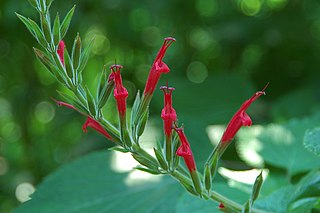
Salvia elegans, a species with several varieties including pineapple sage and tangerine sage, is a perennial shrub native to Mexico. It inhabits Madrean and Mesoamerican pine-oak forests between 6,000 and 9,000 ft.

Salvia yangii, previously known as Perovskia atriplicifolia, and commonly called Russian sage, is a flowering herbaceous perennial plant and subshrub. Although not previously a member of Salvia, the genus widely known as sage, since 2017 it has been included within them. It has an upright habit, typically reaching 0.5–1.2 metres tall, with square stems and gray-green leaves that yield a distinctive odor when crushed. It is best known for its flowers. Its flowering season extends from mid-summer to late October, with blue to violet blossoms arranged into showy, branched panicles.
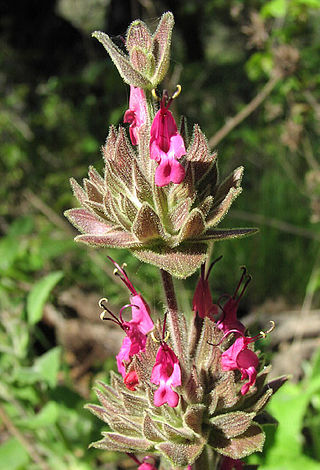
Salvia spathacea, the California hummingbird sage or pitcher sage, is a species of flowering plant in the family Lamiaceae, native to southern and central California growing from sea level to 610 m (2,001 ft). This fruity scented sage blooms in March to May with typically dark rose-lilac colored flowers. It is cultivated in gardens for its attractive flowering spikes and pleasant scent.

Salvia guaranitica, the anise-scented sage or hummingbird sage, is a species of flowering plant in the sage family, Lamiaceae, native to a wide area of South America, including Brazil, Paraguay, Uruguay, and Argentina. It is cultivated all over the world, and is naturalized in New Zealand and Chile.

Salvia splendens, the scarlet sage, is a tender herbaceous perennial plant native to Brazil, growing at 2,000 to 3,000 m elevation where it is warm year-round and with high humidity. The wild form, rarely seen in cultivation, reaches 1.3 m (4.3 ft) tall. Smaller cultivars are very popular as bedding plants, seen in shopping malls and public gardens all over the world.

Salvia pratensis, the meadow clary or meadow sage, is a species of flowering plant in the family Lamiaceae, native to Europe, western Asia and northern Africa. The Latin specific epithet pratensis means "of meadows", referring to its preferred habitat. It also grows in scrub edges and woodland borders.

Salvia greggii, the autumn sage, is a herbaceous perennial plant native to a long, narrow area from southwest Texas, through the Chihuahuan Desert and into the Mexican state of San Luis Potosi, typically growing in rocky soils at elevations from 5,000 to 9,000 ft. It was named and described in 1870 by botanist Asa Gray after Josiah Gregg, a merchant, explorer, naturalist, and author from the American Southwest and Northern Mexico, who found and collected the plant in Texas. It is closely related to, and frequently hybridizes with, Salvia microphylla. Despite the common name "autumn sage", it blooms throughout the summer and autumn.
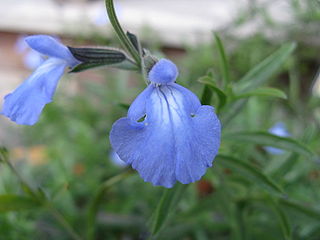
Salvia azurea, the azure blue sage, azure sage, blue sage or prairie sage, is a herbaceous perennial in the genus Salvia that is native to Central and Eastern North America.

Salvia candelabrum is a species of flowering plant in the family Lamiaceae, native to Spain. It is a woody-based perennial growing to 100 cm (39 in), with woolly grey-green leaves that resemble those of the common sage, S. officinalis, and emit a similar scent when crushed. In summer it bears violet-blue flowers on branching stems held high above the foliage.

Salvia leucantha, the Mexican bush sage, is a herbaceous perennial plant that is native to subtropical and tropical conifer forests in central and eastern Mexico. The flowers are usually white, emerging from coloured bracts. It is not frost hardy, but is often grown in warmer latitudes for its prominent arching velvety blue or purple inflorescences.
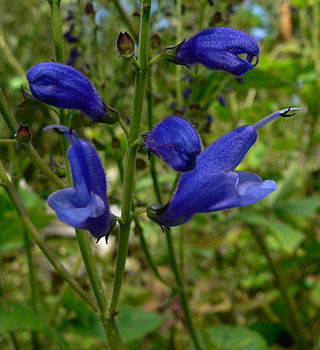
Salvia cacaliifolia, the blue vine sage or Guatemalan sage, is a species of flowering plant in the family Lamiaceae, native to the mountains of Chiapas, Mexico, and in Guatemala and Honduras, at 1,500–2,500 m (4,921–8,202 ft) elevation. It has been available in the United Kingdom for many years, after being recognized by Irish gardener and journalist William Robinson in 1933. Since the 1970s, it has been available in the United States, after Strybing Arboretum and Huntington Botanical Gardens introduced it to California growers.
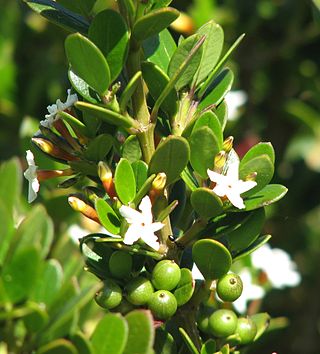
Alyxia buxifolia, otherwise known as the sea box or dysentery bush, is a species of evergreen shrub in the family Apocynaceae.

Salvia involucrata, the roseleaf sage, is a species of flowering plant in the sage family Lamiaceae. This herbaceous perennial is native to the Mexican states of Puebla, Tamaulipas, and Veracruz, growing in shady places such as the edge of forests. Its specific epithet involucrata refers to the prominent flower bracts, which are large and colorful.

Salvia is the largest genus of plants in the sage family Lamiaceae, with nearly 1000 species of shrubs, herbaceous perennials, and annuals. Within the Lamiaceae, Salvia is part of the tribe Mentheae within the subfamily Nepetoideae. One of several genera commonly referred to as sage, it includes two widely used herbs, Salvia officinalis and Salvia rosmarinus.
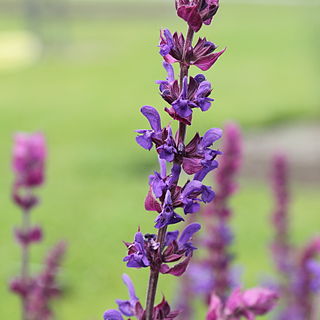
Salvia nemorosa, the woodland sage, Balkan clary, blue sage or wild sage, is a hardy herbaceous perennial plant native to a wide area of central Europe and Western Asia.

Salvia patens, the gentian sage or spreading sage, is a species of flowering plant in the sage family Lamiaceae that is native to a wide area of central Mexico. This herbaceous perennial was introduced into horticulture in 1838 and popularized a hundred years later by the Irish gardener and botanist William Robinson (1838-1935).
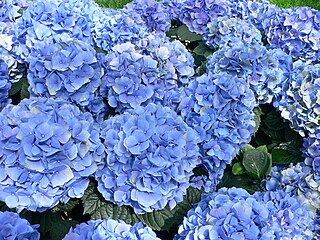
A metalloanthocyanin is a chemical complex giving color to petals of certain plants.

Salvia × superba is a widely grown Salvia hybrid. Its origins are unknown, though it first appeared in cultivation, and its parents are believed to include Salvia × sylvestris and Salvia amplexicaulis. Salvia nemorosa has also been suggested as a direct parent or close relative, but with so many similarities between these species and hybrids, there is no conclusive evidence. It is often mistakenly called Salvia superba.



















